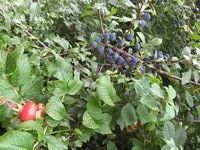 From Little Acorns.....There was some debate today as to whether this was a BEES first – three nature reserves in one day. In the end it the consensus was that it was!
York was our destination and the weather forecast not too promising as we headed East. Our first port of call was St Nicholas Fields, only one mile from the centre of York and on the site of York’s former rubbish tip. An impressive environmental centre with welcome toilets was where we met our guide for the day, Michael Knaggs, who is a York resident but also a member of Bradford Botany Group (just to be clear, we met Michael in the centre, not in the toilets!).
After Michael had guided us to the attractions of this reserve we ate an alfresco lunch untroubled by the threatened rain which had tried very tamely to fall before we headed off to our second reserve at nearby Clifton Backies, a site full of interest as it includes ancient ridge and farrow agriculture as well as the remains of a 2nd World War aerodrome.
From Little Acorns.....There was some debate today as to whether this was a BEES first – three nature reserves in one day. In the end it the consensus was that it was!
York was our destination and the weather forecast not too promising as we headed East. Our first port of call was St Nicholas Fields, only one mile from the centre of York and on the site of York’s former rubbish tip. An impressive environmental centre with welcome toilets was where we met our guide for the day, Michael Knaggs, who is a York resident but also a member of Bradford Botany Group (just to be clear, we met Michael in the centre, not in the toilets!).
After Michael had guided us to the attractions of this reserve we ate an alfresco lunch untroubled by the threatened rain which had tried very tamely to fall before we headed off to our second reserve at nearby Clifton Backies, a site full of interest as it includes ancient ridge and farrow agriculture as well as the remains of a 2nd World War aerodrome.  Smiths PepperwortHere we found fragrant agrimony, a new species for BEES, as was Smith’s pepperwort – henceforth to be known in BEES circles as Amanda’s pepperwort in homage to our favourite Lancashire Lass. Other highlights here were soapwort, hoary ragwort and equal-leaved knotgrass.
We concluded our tour of York with a visit to the YWT reserve of Moorlands, on old Edwardian garden which has grown wild for more than 50 years. Here we saw lots of azaleas and rhodedendrons which must look lovely in Spring when they are flowering at the same time as the daffodils and narcissi which are the chief attraction of this reserve.
Smiths PepperwortHere we found fragrant agrimony, a new species for BEES, as was Smith’s pepperwort – henceforth to be known in BEES circles as Amanda’s pepperwort in homage to our favourite Lancashire Lass. Other highlights here were soapwort, hoary ragwort and equal-leaved knotgrass.
We concluded our tour of York with a visit to the YWT reserve of Moorlands, on old Edwardian garden which has grown wild for more than 50 years. Here we saw lots of azaleas and rhodedendrons which must look lovely in Spring when they are flowering at the same time as the daffodils and narcissi which are the chief attraction of this reserve.
 Sloes and HipsThe overcast weather and cool temperature did not tempt many insects into the sky and our record of butterflies and moths was insignificant.
The common feature of all the reserves was the quanity of fruits and fungi, reminding us that Autumn is not far away. Haws, hips, sloes, damsons, blackberries, apples, pears and elderberries there were in profusion and we were surprised to see so few birds feasting on this bounty, although a flock of starlings, radiant in their different plumages, was the exception. The Autumn thrushes will be pleased to find that such a rich harvest awaits them!
Alice recorded 115 different plants at the first site, 37 at the second and 19 at the third, a total of 171 for the day of which 132 were in flower.
The weather brightened up as the day progressed so we were able to reflect on another successful BEES foray as we crawled along in the M62 traffic before eventually returning safely to Bradford. Many thanks to Eric for organising another successful day and to Michael for guiding us through it.
Sloes and HipsThe overcast weather and cool temperature did not tempt many insects into the sky and our record of butterflies and moths was insignificant.
The common feature of all the reserves was the quanity of fruits and fungi, reminding us that Autumn is not far away. Haws, hips, sloes, damsons, blackberries, apples, pears and elderberries there were in profusion and we were surprised to see so few birds feasting on this bounty, although a flock of starlings, radiant in their different plumages, was the exception. The Autumn thrushes will be pleased to find that such a rich harvest awaits them!
Alice recorded 115 different plants at the first site, 37 at the second and 19 at the third, a total of 171 for the day of which 132 were in flower.
The weather brightened up as the day progressed so we were able to reflect on another successful BEES foray as we crawled along in the M62 traffic before eventually returning safely to Bradford. Many thanks to Eric for organising another successful day and to Michael for guiding us through it.Stuart
